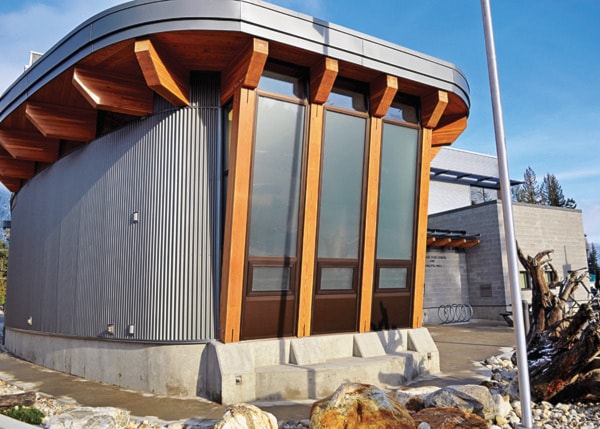The District of Sicamous is going for gold.
Municipal council has approved spending $4,500 to verify the municipality’s $4 million civic centre, officially opened in July 2011, meets a gold standard in Leadership in Energy and Environmental Design (LEED), a rating system for sustainable design, construction and operation of a building.
Monica Baillie of Landmark Architecture explained to council what went into the building, which includes the municipal town hall, as well as the community’s library and museum, to meet and exceed basic LEED certification and push the structure into gold territory.
A point system is utilized, which takes into account a wide range of factors that include everything from the building’s central location, to the geo-exchange system used to heat and cool the facility, to all the locally sourced and/or recycled material used in its construction.
The fact that the building can be expanded to include a third floor within the same footprint is another asset recognized under LEED.
Final LEED classification will come from the Canada Green Building Council.
Baillie said the question arose whether or not the civic centre could qualify for LEED’s highest rating of platinum. She said it’s something that could be looked at, that there may be some way to earn the additional points needed in the LEED rating system. But, she continued, the effort may not be worth the additional cost, as the building already exceeds what was originally envisioned.
“I can tell you, when we started the process, we were going for the lowest level possible, we were just planning to go for LEED certified, which is to say, we were going to use resources wisely, use local materials,” said Baillie. “But we went with… a better system for heating and cooling delivery, and we got much more. It’s hard to describe the level, but 85 per cent of the material in the ceiling tile is recycled… many things you touch are recycled or local.”
Coun. Don Richardson, the only councillor to vote against pursuing gold certification, questioned what benefit the taxpayer will see.
“Geothermal is great, but it has flaws in it. There’s the recycled material, that’s great. But if we’re looking at getting points all the time, in the end, what’s the real benefit in it,” asked Richardson. “I still think we spent a lot of money on assumptions or feel-good stuff.”
Baillie told Richardson that getting bang for the buck is a common consideration of her design team, but that in Sicamous’ case the end result is a healthy, durable building.
“It wasn’t my idea to do LEED – In fact, we sat down and said, ‘you know, we charge a premium for doing this. And we’d just as soon reduce that premium for something else,’” explained Baillie. “But, if you want a third party to tell you that we’re doing our job, this is how you do it. And that decision was made. And it’s a valid decision. A lot of municipalities and the province itself have all bought into that, and for a reason. Because it’s one way to say you did get what you paid for.”
Coun. Fred Busch took advantage of having the building’s architect in council chambers to comment on the room’s poor acoustics. Baillie said acoustic wall panels were part of the original design, but were removed to cut costs. She added they could still be put in.
Unlike Richardson, Busch, said he had no problem with LEED, and suggested it may even give the district some bragging rights.
“You have huge bragging rights considering the size of your community… “ confirmed Baillie. “I don’t think too many other communities this size in B.C. have been forward thinking. They’ve developed water treatment plants and that kind of thing. But not too much like this.”
Coun. Suzanne Carpenter said she loves the building, but questioned if solar energy might have been an option. Baillie said it would have been too costly and the payback period too long.
